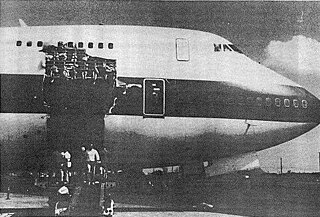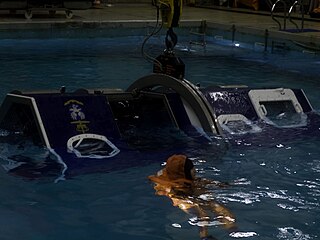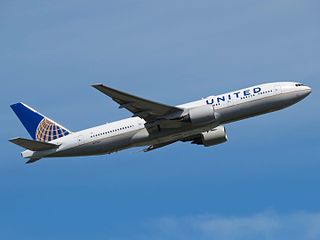
A flight attendant, traditionally known as a steward or stewardess ; or air host or hostess, is a member of the aircrew aboard commercial flights, many business jets and some government aircraft. Collectively called cabin crew, flight attendants are primarily responsible for passenger safety and comfort.
The basic principles of air navigation are identical to general navigation, which includes the process of planning, recording, and controlling the movement of a craft from one place to another.

The Kegworth air disaster occurred when British Midland Airways Flight 092, a Boeing 737-400, crashed onto the motorway embankment between the M1 motorway and A453 road near Kegworth, Leicestershire, England, while attempting to make an emergency landing at East Midlands Airport on 8 January 1989.
To assume a brace position or crash position is an instruction that can be given to prepare for a crash, such as on an aircraft; the instruction to "Brace for impact!" or "Brace! Brace!" is often given if the aircraft must make an emergency landing on land or water. There are many different ways to adopt the brace position, with many countries adopting their own version based on research performed by their own aviation authority or that of other countries. The most common in passenger airliners being the forward-facing seat version, in which the person bracing places their head against or as close as possible to the surface it is likely to strike, placing their feet firmly on the floor, and their hands either on their head or the seat in front.

Scandinavian Airlines System Flight 751 was a regularly scheduled Scandinavian Airlines passenger flight from Stockholm, Sweden, to Warsaw, Poland, via Copenhagen, Denmark. On 27 December 1991, a McDonnell Douglas MD-81 operating the flight, registration OY-KHO, piloted by Danish Captain Stefan G. Rasmussen (44) and Swedish first officer Ulf Cedermark (34), both experienced pilots with 8,000 and 3,000 flight hours, respectively, was forced to make an emergency landing in a field near Gottröra, Sweden. Ice had collected on the wings' inner roots before takeoff, broke off, and was ingested into the engines as the aircraft became airborne on takeoff, ultimately disabling both engines. All 129 passengers and crew aboard survived.

Aircrew, also called flight crew, are personnel who operate an aircraft while in flight. The composition of a flight's crew depends on the type of aircraft, plus the flight's duration and purpose.

United Airlines Flight 811 was a regularly scheduled airline flight from Los Angeles to Sydney, with intermediate stops at Honolulu and Auckland. On February 24, 1989, the Boeing 747-122 serving the flight experienced a cargo-door failure in flight shortly after leaving Honolulu. The resulting explosive decompression blew out several rows of seats, killing nine passengers. The aircraft returned to Honolulu and landed with no further incident.

Midwest Express Airlines Flight 105 was a scheduled domestic passenger flight that crashed into an open field in Milwaukee, Wisconsin shortly after taking off from General Mitchell International Airport on September 6, 1985. The airplane, a Douglas DC-9, was carrying 31 passengers and crew. None of them survived the crash.

A pre-flight safety briefing is a detailed explanation given before take-off to airline passengers about the safety features of the aircraft they are aboard.

A gin pole is a supported pole that uses a pulley or block and tackle on its upper end to lift loads. The lower end is braced or set in a shallow hole and positioned so the upper end lies above the object to be lifted. The pole is secured with three or more guy-wires. These are manipulated to move the load laterally, with up and down controlled by the pulley or block. In tower construction, a gin pole can also be “jumped” up the completed sections of a tower to lift the higher sections into place.
The structure of the United States Air Force refers to the unit designators and organizational hierarchy of the United States Air Force, which starts at the most senior commands.

Aircraft emergency oxygen systems or air masks are emergency equipment fitted to pressurized commercial aircraft, intended for use when the cabin pressurisation system has failed and the cabin altitude has climbed above a safe level. It consists of a number of individual yellow oxygen masks stored in compartments near passenger seats and near areas like lavatories and galleys, and an oxygen source, like a centralized gaseous cylinder or decentralized chemical oxygen generator.

Overwing exits are found on passenger aircraft to provide a means of evacuation onto the wing, where passengers continue off the trailing edge, either by sliding down the extended flaps or by using an evacuation slide that deploys when the exit is opened.
A birth attendant, also known as skilled birth attendant, is a health professional who provides basic and emergency care to women and their newborns during pregnancy, childbirth and the postpartum period. A birth attendant, who may be a midwife, physician, obstetrician, or nurse, is trained to be present at ("attend") childbirth, whether the delivery takes place in a health care institution or at home, to recognize and respond appropriately to medical complications, and to implement interventions to help prevent them in the first place, including through prenatal care. Different birth attendants are able to provide different levels of care.

Helicopter Underwater Egress Training ; often abbreviated as HUET, pronounced hue-wet, hue-way or you-way) is training provided to helicopter flight crews, offshore oil and gas industry, law enforcement personnel, and military personnel who are regularly transported by helicopters over water. As the name implies, the purpose of this training is to prepare passengers and crew for an emergency evacuation or egress in the event of a crash landing on water.
An exit row is a row of seats on board a commercial airliner that is next to an emergency exit. Exit rows may be next to overwing exits or full-sized exit doors.

The JetBlue flight attendant incident occurred after JetBlue Airways Flight 1052, from Pittsburgh to New York City on August 9, 2010, had landed at John F. Kennedy International Airport. Steven Slater, a veteran flight attendant announced over the plane's public address system that he had been abused by a passenger and was quitting his job. He then grabbed and guzzled two beers and exited the plane by deploying the evacuation slide and sliding down it. Slater claimed to have been injured by a passenger when he instructed her to sit down. His account of the event was not corroborated by others who claimed he hip-checked the woman.
Space neuroscience or astroneuroscience is the scientific study of the central nervous system (CNS) functions during spaceflight. Living systems can integrate the inputs from the senses to navigate in their environment and to coordinate posture, locomotion, and eye movements. Gravity has a fundamental role in controlling these functions. In weightlessness during spaceflight, integrating the sensory inputs and coordinating motor responses is harder to do because gravity is no longer sensed during free-fall. For example, the otolith organs of the vestibular system no longer signal head tilt relative to gravity when standing. However, they can still sense head translation during body motion. Ambiguities and changes in how the gravitational input is processed can lead to potential errors in perception, which affects spatial orientation and mental representation. Dysfunctions of the vestibular system are common during and immediately after spaceflight, such as space motion sickness in orbit and balance disorders after return to Earth.
The International Board for Research into Aircraft Crash Events (IBRACE) was founded on 21 November 2016 by a group of subject-matter experts in aviation, engineering, clinical medicine, and human factors. These experts are associated with organizations that include the Civil Aerospace Medical Institute, USA (CAMI); Cranfield University, England; GRM Consulting Ltd., England; Spire Liverpool Hospital, England; TÜV Rheinland, Germany; the University of Calgary, Canada; the University of Nottingham, England; and Wonkwang University, Korea.

On February 13, 2018, around noon local time, a Boeing 777-222 airplane, operating as United Airlines Flight 1175 (UA1175), experienced an in-flight separation of a fan blade in the No. 2 (right) engine while over the Pacific Ocean en route from San Francisco International Airport (SFO) to the Daniel K. Inouye International Airport (HNL), Honolulu, Hawaii. During level cruise flight shortly before beginning a descent from flight level 360, and about 120 miles from HNL, the flight crew heard a loud bang, followed by a violent shaking of the airplane, followed by warnings of a compressor stall. The flight crew shut down the failed engine, declared an emergency, and began a drift-down descent, proceeding direct to HNL where they made a single-engine landing without further incident at 12:37 local time. There were no reported injuries to the 374 passengers and crew on board and the airplane damage was classified as minor under National Transportation Safety Board (NTSB) criteria.












